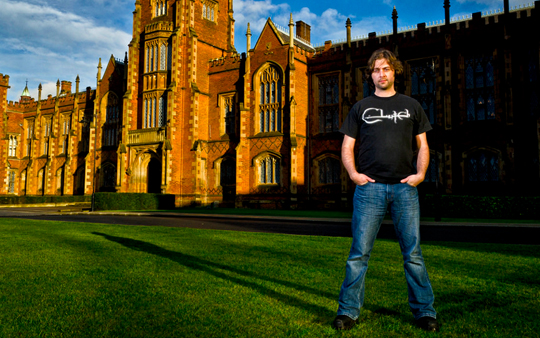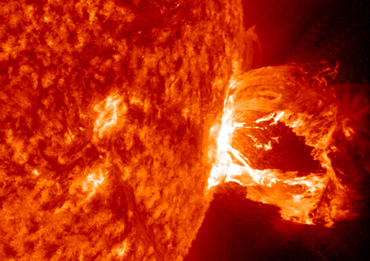Internationally renowned Queen’s University researcher Dr Ryan Milligan originally from Ardglass has made a cosmic leap and will be working with NASA scientists on studies into solar flares.
Down News caught up with Ryan just about to board a plane for Washinton DC en route to the NASA centre where he has been working periodically for ten years on top level projects. A former lorry driver, Ryan arrived at QUB Belfast as a mature student to study astrophysics and space science and after several years on the road driving to support himself through his studies, he graduated with a doctorate.
Ryan worked off and on with the Goddard NASA centre for ten years and is now delighted at the new opportunity to live his dream.
He said: “I think it all started when I was fascinated by Hayley’s Comet when I was eleven years old… I was amazed how it travelled round the solar system every 76 years. I then developed an interest in the stars and it all started from there. I initially studied at St Patrick’s Grammar School in Downpatrick and moved St Patrick’s in Armagh. I had a few years out in the haulage business working for companies in Ardglass, Marks and Spencers and also Maxwell Freight. It helped pay my way through university and I’m now rubbing shoulders with the world’s leading scientists in the field of solar flares at NASA.”
[caption id="attachment_51494" align="aligncenter" width="540"] Dr Ryan Milligan, who is working with NASA of an international collaboration on a solar flare project.[/caption]
Dr Ryan Milligan, who is working with NASA of an international collaboration on a solar flare project.[/caption]
When quizzed about the possibility of one day making a space flight, Ryan said: “I like to have my feet firmly on the ground.”
A major new collaboration between the Astrophysics Research Centre (ARC) at Queen’s University Belfast and American space agency NASA is set to investigate the phenomenon of solar flares and their potential to cause disruption here on Earth.
Explosions in the Sun’s atmosphere, solar flares, result in significant increases in ultra-violet radiation. While the physics behind this phenomenon is still unknown, the increased UV radiation and the associated solar storms can disrupt radio communication and GPS, with potentially dangerous knock-on effects for a range of activities including air-traffic control and search-and-rescue missions. Solar storms can also be associated with the visual spectacle known as the Northern Lights which is caused by charged particles streaming from the Sun.
NASA, in conjunction with the Catholic University of America, has awarded $330,000 to the project. which will be headed up by internationally renowned Queen’s researcher Dr Ryan Milligan and will straddle QUB Belfast and NASA’s Goddard Space Flight Center outside Washington DC.
[caption id="attachment_51497" align="alignright" width="370"] A solar flare from our sun.[/caption]
A solar flare from our sun.[/caption]
Dr Milligan added: “Solar flares can have significant effects on modern life. For example, they can throw GPS off by quite significant distances – tens of metres – so considering how many services now rely on GPS, that’s a lot of potential for chaos.
“As a global society, we are starting to come to terms with the significance of all of this. I am working with scientists from around the world. We are looking at lots of ideas such as space craft design and how to manage our satellite systems that we are increasingly dependent on.
“The UK Met Office has recently begun research into ‘space weather’ while the insurance brokers Lloyds of London have classified solar flares as a major insurance risk. My job is to understand the physics behind these explosions. The more we can understand how and why they happen, the more we can try to predict them and hence, to mitigate their effects.”
Director of the Astrophysics Research Centre at Queen’s, Professor Stephen Smartt said: “Over the last few years, Ryan’s work has had major international impact and the NASA grant he was awarded shows his growing reputation as a renowned scientist. It is a pleasure to have him at Queen’s as a visiting fellow and for us to collaborate with him on this project. Ryan is an excellent student mentor and we hope to offer opportunities for local students to travel to the Goddard Space Flight Center to experience research in a NASA institute.”
Dr Milligan’s research is based on data from the ‘Solar Dynamics Observatory’ spacecraft, NASA’s flagship Living With A Star Program mission, which was launched into space almost five years ago to analyse the interaction of the Sun with the Earth’s atmosphere.
The former HGV driver from Co Down whose family are much involved in the local fishing industry, worked as a research associate at NASA’s Goddard Space Flight Center for five years after completing his undergraduate degree and PhD as a mature student at Queen’s. To find out more about ARC, see:
The Astrophysics Research Centre (ARC) is one of Queen’s University’s leading research clusters encompassing both observational and theoretical astrophysics. It holds substantial grant funding from the UK’s STFC, EPSRC, the Royal Society, the Leverhulme Trust and EU funding through the European Research Council and FP7
ARC is a partner in major international partnerships including Pan-STARRS1, the Next Generation Transit Survey, HARPS-N, and EUCLID. ARC staff built and operate the ROSA high-cadence imager, the SuperWASP transit facility and ARC now leads one of ESO’s public surveys, PESSTO.
In recent years ARC staff have been awarded the RAS Group Prize, an ERC Advanced Grant, a Royal Society research fellowship, and election to the Royal Irish Academy. ARC is part of the Queen’s Foundation 5-year fundraising campaign.
NASA’s Goddard Space Flight Center is home to the USA’s largest organization of combined scientists, engineers and technologists that build spacecraft, instruments and new technology to study Earth, the sun, our solar system and the universe. Named after American rocketry pioneer Dr Robert H Goddard, it was established in 1959 as NASA’s first space flight complex. Goddard and its several facilities are critical in carrying out NASA’s missions of space exploration and scientific discovery.
]]>
























